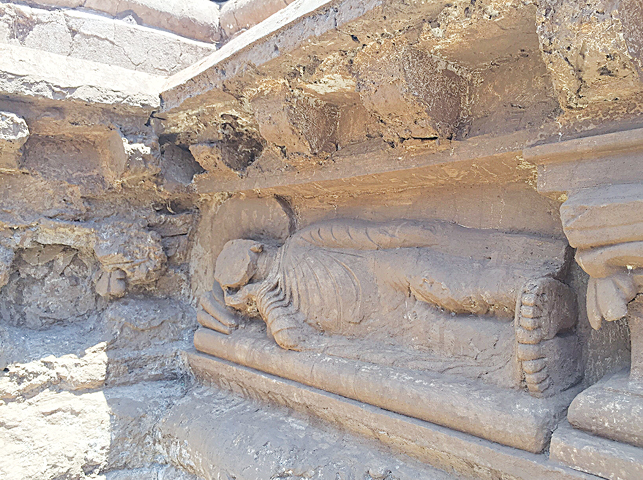
WHEN Hazara University’s Abdul Hameed showed me the Sleeping Buddha, I was underwhelmed. “These are the feet,” he said pointing to what looked like a jagged brick wall. “And here are the folds of his dress.” I squinted and asked him thrice to point out the feet again before I figured out that what I thought were broken bricks are actually the toes.
It is in a sad shape though. The 14-metre statue of Buddha in a state of nirvana — Buddha Parinirvana or the Sleeping Buddha — no longer has a head. Placed on a platform, it was once the centrepiece of a death scene. Carbon-dating from smaller figures found at the death scene as well as coins suggest it is 1,800 years old — making it the largest found in Pakistan, the oldest in South Asia. Another unusual feature is that it was made in the sand-coloured Kanjur stone, a material mostly used to construct buildings. Khyber Pakhtunkhwa’s archaeology department is still cleaning away the debris and making a composite picture of this find.
“This chamber was a two-storey building but it collapsed on the Sleeping Buddha,” says Hameed, who is the field director for the excavation. “We found the upper leg and fragments of the body on the floor. Robbers looted this tomb and it was also damaged by the collapse of the roof.”
Now, a bright yellow metal roof and staff protect this precious discovery.
The site is Bhamala in Khanpur, KP’s Haripur district, atop a knoll with a magnificent view of the aqua Haro River, ringed on three sides by hills. A winding, sometimes broken road leads up to this Buddhist shrine and monastery, put on the Unesco list of protected sites in 1980.
Bhamala was discovered and documented in 1930-31 by the English director general of the Indian Archaeological Survey, Sir John Marshall, at least a decade after he had found Harappa and Mohenjodaro. But his interest was in the large, and unusual cuneiform-shaped stupa or shrine at Bhamala, which is to the left of the death scene chamber. “He didn’t think the pile of debris was worth investing money in for further excavations,” says Hameed.
What remains of the chamber is lined with friezes on one side. With the help of informally trained Gandhara art sculptors, KP’s archaeological department has restored some of the statues. These include another uncommon find — double-halo Buddha figurines. On a smaller stupa at the site is, what Hameed tells me, probably a smaller version of the Sleeping Buddha in near perfect condition. It lies to the side, body enrobed, hand tucked under the face; a state of nirvana after death, released from rebirth.
Hameed takes me to meet one of the sculptors who helped the department restore some of the figurines. Iftikhar Ahmed and Hameed talk shop as I look at some of the statues he has sculpted on commission at his home in Taxila. They are intricate things of beauty. “You wouldn’t be able to tell them from the real thing,” says Hameed. “Only a scholar or archaeologist would know.”
“It’s only a few years ago that the department decided to use the services of people like us for restoration work,” Ahmed tells me over sweet tea and biscuits.
“People like us?”
“Yes. According to the British-era Antiquities Act, making replicas is illegal. We’re probably one of the few countries in the world where this is so. The government should revise the law. I know so many sculptors like myself who learnt the art in Taxila and then moved to Thailand where they are minting money.”
“Do you want to move elsewhere?”
Ahmed grins. “I’m doing fine here.”
Ahmed’s grandfather learnt how to make Gandhara sculptures before Partition when he was a labourer working on sites with British archaeologists. A busy man clearly in demand, Ahmed says only another uncle of his are continuing the family tradition.
He says that he could restore Bhamala’s Sleeping Buddha in two or three months if he had eight or ten sculptors.
“You must have seen the statue is broken, some parts had fallen off and we’ve stored them so we can use them later. We would have to buy the missing stone. It could cost ten million rupees.”
But the KP archaeology department is short on resources. It had little choice but to enlist the expertise of the men who make replicas of ancient artefacts. There are no formally trained restoration experts in Pakistan and it would be too expensive to hire foreigners. Even now, there is much work to be done to fully unearth the Sleeping Buddha figure and restore it.
Despite the ravages of nature and men, Bhamala feels almost undisturbed, still sacred. But its serenity is probably because visitors are scarce. The Sleeping Buddha was a secret buried under rubble for centuries; in a sense even after its excavation, it is yet to be discovered by the world.
The writer is multi-media journalist with the BBC World Service
Published in Dawn, June 12th, 2016












































